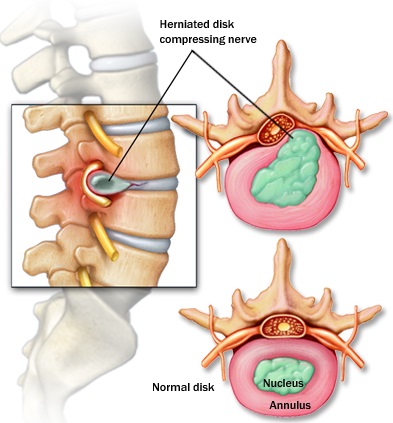The vertebral spaces are protected and conditioned by small discs that act as 
shock-absorber to minimize the effect of trauma and assault on the vertebral bodies. Damage to these discs can result in disc herniation, a serious condition characterized by protrusion of vertebral disc from the intervertebral spaces. Herniated disc is also termed as slipped disc or ruptured disc. This condition is extremely painful as it compresses the surrounding nerves, thereby causing severe pain in the back and neck region, along with weakness in the muscles of hands and feet. Herniated disc surgery is usually the last resort to address symptoms.
What Is Herniated Disc Surgery?
Herniated disc surgery is one of the interventions to prevent the complications of disc herniation. The nature of surgical or conservative treatment depends largely on the severity of symptoms. Although some people may not require any specific treatment, others may require surgical intervention to address extreme pain and complications of disc protrusion. Here are few popular varieties of herniated disc surgery:
1. Laminectomy
Laminectomy makes a small cut over the spinal lamina in such a way that the nerve root does not get irritated. The incision or cut is so small that a microscope is used to make the incision in a precise manner.
This technique is also referred to as laminectomy because the surgeon may opt to remove the lamina (partially or completely), depending on the severity of the condition.
2. Microdiskectomy
It is also referred to as Disketomy and is regarded as one of the most commonly adapted method for the treatment of herniated disc.
In this procedure, a small incision is made along the back side to access the disc. Then the physician removes a small portion of the protruded disc that is causing pressure and pain symptoms. This process is a less invasive technique for the treatment of herniated discs.
3. Artificial Disc Surgery
Artificial disc surgery is performed when the whole disc needs to be replaced. This treatment option is usually not opted if the patient is suffering from arthritis or osteoporosis.
During this procedure, an incision is made in the abdominal region. Then the ruptured disc is replaced with an artificially-made metal or plastic disc. This is typically an invasive procedure and is typically performed under general anesthesia.
4. Spinal Fusion
Spinal fusion is also one of the invasive herniated disc treatments. In this procedure, a bone graft is usually used, which can be taken from another body part of the same person or donated by a donor. With this graft two vertebrae are fused to cover the herniated disc. For better understanding please refer to this video:
How to Take Care of Yourself After Herniated Disc Surgery
It is noteworthy that all types of herniated disc surgery are associated with some risks and adverse effects. In some severe cases, the surgical technique may cause nerve damage or other complications like infections, internal bleeding, etc. If the disc is not removed, then the rupture may appear again, leading to degenerative disc disease. If spinal fusion is performed, then stiffness can appear which may result in a permanent degenerative issue. Hence taking care of your health after herniated disc surgery is essential and following measures can be taken for better care:
1. Right After Surgery
Right after the completion of herniated disc surgery, nurses and paramedic staff provide post anesthesia care. The initial step is to record the blood pressure and pulse at regular intervals. As soon as you start to recover, the nurse will ask you to take deep breaths in order to maintain an adequate supply of oxygen throughout the body.
2. Care for Incision
After surgery the surgical dressing is applied to prevent infection and is removed 2 to 3 days of surgery. Then you may use clean gauze to protect your incision if you like. Besides, you should do follow-up exams after one or two weeks of surgery.
3. Take Shower with Care
Taking shower is allowed after one to two days of herniated disc surgery. Try not to scrub the area of incision and do not run water directly over it. If the wound is oozing or there is any drainage, immediately contact the health care provider and do not take showers.
4. Do Exercise Properly
- Slow walk is the only recommended exercise for individuals who are recovering from herniated disc surgery.
- Initially short frequent walks are advised, which should be gradually increased to long walk to optimize incision healing.
- Lifting weights and prolonged sitting such as in long drive should be avoided as it puts pressure over the disc directly.
- You should also maintain a good posture while standing or sitting, and don't bend the back too much.
5. Reduce Constipation
Generally, the restriction of physical activities right after the surgical procedures can lead to constipation. Fiber rich diets are needed to aid in addressing the condition. Most physician recommends drinking lots of water to activate the body metabolism and reduce constipation.
6. When to Return to Work
People who have less active and more sitting jobs can go back to their work within one week of herniated disc surgery. On the other hand, individuals who have strenuous and more dynamic job needs to rest for a longer period of time and should return to their work after achieving complete recovery.
When to See a Doctor
Contact a healthcare provider if any of the following symptoms appear:
- Constant pain which is not relieved even after taking painkiller
- High grade fever
- Appearance of bruises around or drainage from incision site